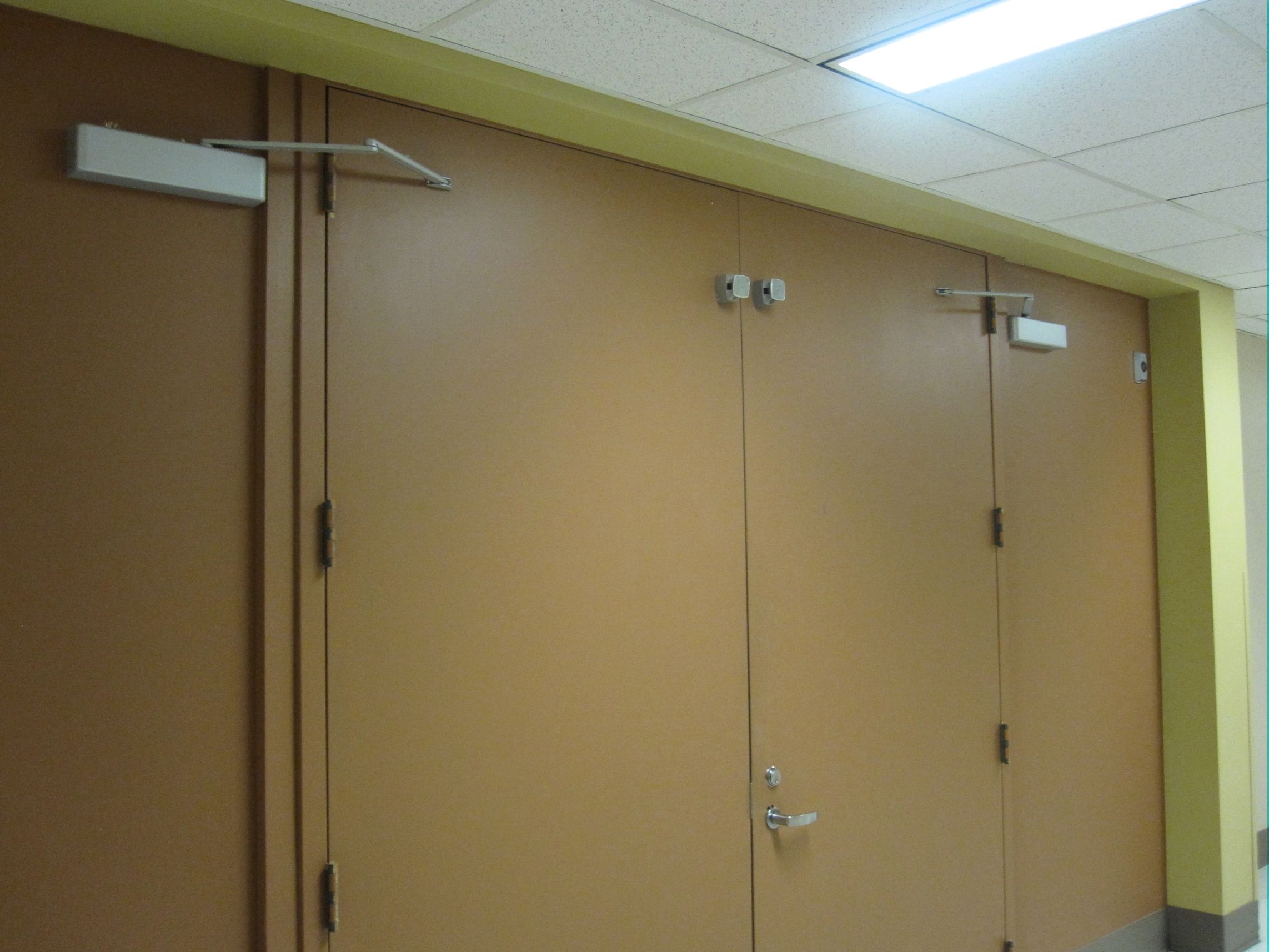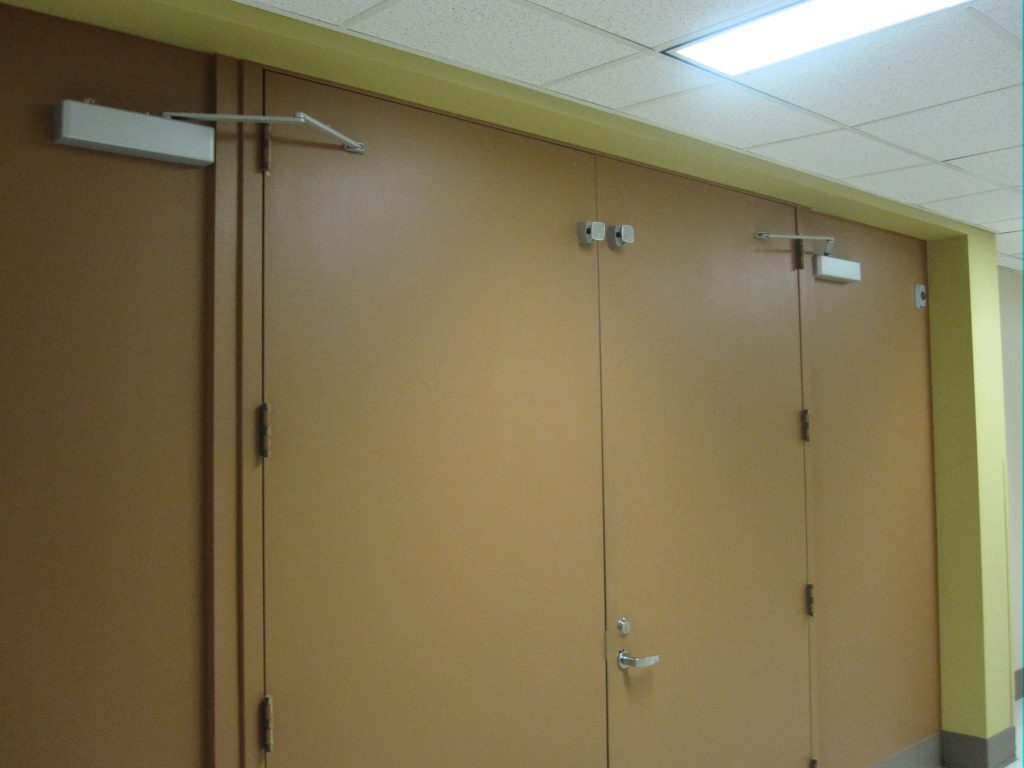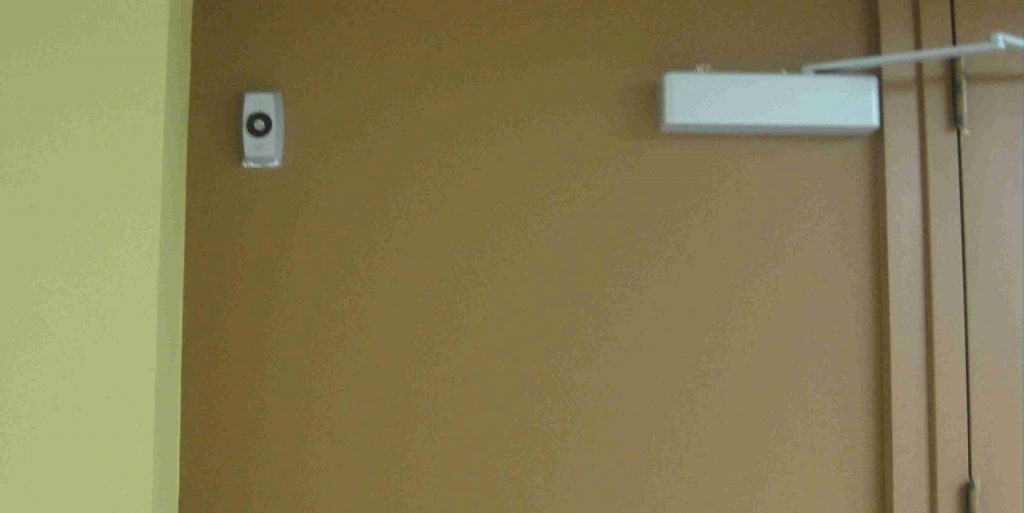Pete Schifferli of Expert Locksmith sent me these Fixed-it Friday photos (this is not his handiwork). These are new doors in a hospital corridor, and the closers are mounted to the wall on each side to allow the doors to open 180 degrees and engage the electromagnetic holders.
Anybody know how this mounting style will affect the operation of the closers?
You need to login or register to bookmark/favorite this content.








I don’t know a lot about closer internals, but I’ll bet those have absolutely no leverage when the doors are almost closed. I wonder if the door latches reliably on its own?
Also the hold open armatures aren’t level with each other, they’re off by 1/8″ – 1/4″. Ugly.
LCN is great about coming up with answers and special solutions, such as mounting a track arm closer with the track inverted on a exterior gate to keep leaves and trash out of the track.
These don’t look like Sargent closer covers but Sargent actually makes a closer specifically for this purpose. They consider it a pocket door application (as in door sits in a pocket when open) but it will also work in this scenario. It’s the 351 OP. They also make a track arm version but it will only swing 90°. These do look like they’re installed a little low. If these are hollow metal doors, they may have missed the closer reinforcements completely. Just make sure your mag holder sticks our farther than the closer.
LCN also makes a closer for a door that opens into a pocket – the 4000T, but it’s for 90-degree doors.
– Lori
I’d assume you would need to turn up the spring on the closer 2 or 3 turns to compensate for this mounting?
Well lets see because of the delay for the door to close and even more the actual ability for the door closer to hold the weight of the door for that extend period of time.
Because we do a fair amount of mounting standard door closers (either Norton or LCN cast aluminum) on gates we see this type of mounting challenge regularly. This is also not an uncommon application for elevator lobby area doors (like thses apear to be.
The tech services depts At LCN or Norton are great at giving you exact measurements so that the valving continues to work as it was designed to work. Although the installation looks awkward or funny, the closer can still work and be adjusted for sweep, closing speed, etc.
Talk about overextending the capabilities of a closer – Gees Louis ! The hold open extension from the face of the door does not seem adequate to extend to the magnetic plate of the hold open on the wall – the obstruction would be the closer. It also appears that the closer armature may also prevent the door from being opened 180°. Where is the coordinator for these doors? Based on the lockset they lock into each other. Only possible if the door with no locking devise closes first. Wonder if the closers actually work in this application ?
I’d be surprised if they have the power to shut completely.
Won’t the door hit the closer body before the mag hold open?
If these doors aren’t opened and closed often spring hinges might have been easier and a little more astatically pleasing. Obviously if they are high usage you would want the closers for better control.
The closer bodies will interfere with the wall mags making a connection with the mag arm on the door!
My questions are do they go through a whole back check,sweep,latch cycle?
How about the longevity due to the arm angle geometry?
Those closers are installed with the “Do whatever the heck you want” template, not included in the box. I am guessing that the inside of the door frame looks like the outside and there was an issue with proper mounting. If the closers are mounted with the shaft the same distance from the hinge center line as per template, they may seem to work ok, but the parameters are all wrong. I am guessing this “cluster” will not work for long. If it were computerized, it would come up with an ID-10-T error (ID10T) soon. It would not happen here on a new install.
In addition to the above statements the hinges appear to be regular five knuckle full mortise hinges. Based on the proximity of the closer to the top hinge there is no chance that the doors will open 180°. Perhaps the are swing clear hinges? Doubt it ! Hardware installer needs to go back to school.
David,
Can you elaborate on your comments? Are you concerned that the face of the door would hit the closer cover when opened 180 degrees?
I’m assuming this is a 1-3/4″ thick door. Standard 4-1/2″ hinges provide 1-1/2″ of clearance between the face of the door and the face of the frame at 180 degrees. Standard 4″ hinges provide 1″ of clearance. In this case, the closer is mounted in a pocket. The pocket appears to be AT LEAST half as deep as the closer projection. Most closers project 2″ to 2-1/4″. Assuming the pocket is an inch deep and the closer projects 2-1/4″ there would still be enough room to allow the door to swing 180 degrees. What would be gained by using swing-clear hinges? What am I missing? Did you mean to say wide-throw hinges?
I know that’s a lot of assumptions but I think they are safe assumptions (and probably on the conservative side).
Also it looks like the trim rose is a little to small to cover up the mortise lock retro fit.
The door control is a DORMA 8907 and the mount is a pocket door mount. See the DORMA downloads page and look for this template in the 8900 section: PKT 180 Pull Side Pocket Closer (closer in pocket wall, arm on door). (It is the 4th template from the bottom of the page.) The door control will close the door. As long as the pocket is proper depth (and it appears to be), the door control will not hit the door as others have mentioned. The biggest issue with this mount is opening the doors to full open position (in contact with wall magnet) requires three men to push the Size 7 closer all the way open. (Just kidding about the 3 men, but fully opening the door is difficult due to the very strong spring in the door control body.)
Concealed closer 3030 or 5010 could have been a better choice.
Just out of curiosity, is there a picture you could link to that shows how you should actually do an installation like this?
Another Bill Elliott spec…..
They will work fine for years to come! We’ve been doing that with “Total Doors” forever. The keys to it working are; backing in the wall and the pocket in which the mag and closer are mounted in.
Spring hinges on a door that big? Maybe as assistance to a closer but no way as a replacement.
I would think a concealed closer mounted in the frame head would be the most appropriate method here.
This mounting is required when you want to slam the wall shut.